The HTC One (M8) Review
by Anand Lal Shimpi & Joshua Ho on March 26, 2014 7:00 PM EST- Posted in
- Smartphones
- HTC
- Mobile
- HTC One
Snapdragon 801 Performance
The M8 is the first smartphone we’ve tested to use Qualcomm’s newly announced Snapdragon 801 SoC. At a high level the 801 is a frequency bump enabled by a 28nm HPm process push, giving it a tangible increase in performance (and potential decrease in power consumption) compared to the outgoing Snapdragon 800. The table below compares the 801 variants to the Snapdragon 800:
| Snapdragon 800/801 Breakdown | ||||||||||
| SoC Version | Model | Max CPU Frequency | Max GPU Frequency | ISP | eMMC | DSDA | Memory IF | |||
| MSM8974VV | v2 | S800 | 2.2GHz | 450MHz | 320MHz | 4.5 | N | 800MHz | ||
| MSM8974AA | v2 | S800 | 2.3GHz | 450MHz | 320MHz | 4.5 | N | 800MHz | ||
| MSM8974AB | v2 | S800 | 2.3GHz | 550MHz | 320MHz | 4.5 | N | 933MHz | ||
| MSM8974AA | v3 | S801 | 2.3GHz | 450MHz | 320MHz | 5.0 | Y | 800MHz | ||
| MSM8974AB | v3 | S801 | 2.3GHz | 578MHz | 465MHz | 5.0 | Y | 933MHz | ||
| MSM8974AC | v3 | S801 | 2.5GHz | 578MHz | 465MHz | 5.0 | Y | 933MHz | ||
In most parts of the world the M8 will ship with a 2.3GHz Snapdragon 801. In Asia/China however we’ll see the 2.5GHz MSM8974AC v3 SKU instead.
Compared to the outgoing Snapdragon 800, peak CPU performance shouldn’t increase all that much. What we may see however is an improvement in power efficiency thanks to the improved 28nm HPm process.
It’s really the GPU that will see the largest increase in performance. With a maximum speed of 578MHz and paired with faster LPDDR3-1866 memory, we should see up to a 30% increase in GPU bound performance over Snapdragon 800 designs.
- Physics
| Snapdragon 801 vs 800 vs 600 | |||||||
| HTC One (M8) - Snapdragon 801 | Google Nexus 5 - Snapdragon 800 | HTC One (M7) - Snapdragon 600 | 801 vs 800 | 801 vs 600 | |||
| SunSpider 1.0.2 | 772.8 ms | 686.9 ms | 1234.8 ms | -12% | +37% | ||
| Kraken Benchmark 1.1 | 6745.2 ms | 7245.9 ms | 12166.5 ms | +7.4% | +45% | ||
| Google Octane v2 | 4316 | 3726 | 3103 | +16% | +39% | ||
| WebXPRT Overall | 373 | 392 | 244 | -5% | +53% | ||
| AndEBench - Native | 17430 | 17480 | 12381 | -1% | +41% | ||
| 3DMark 1.1 Ultimate | 19631 | 17529 | 10519 | +12% | +87% | ||
| 3DMark 1.1 Ultimate - Physics | 50.5 | 51 | 33.1 | -1% | +53% | ||
| Basemark X 1.1 - HQ | 12194 | 11275 | 4807 | +8.1% | +154% | ||
| GFXBench 3.0 - Manhattan Onscreen | 11.1 fps | 9.3 fps | 5.1 fps | +19% | +118% | ||
| GFXBench 3.0 - Manhattan Offscreen | 10.4 fps | 8.7 fps | 4.4 fps | +20% | +136% | ||
| GFXBench 3.0 - T-Rex HD Onscreen | 29.9 fps | 24.3 fps | 12.6 fps | +23% | +137% | ||
| GFXBench 3.0 - T-Rex HD Offscreen | 27.9 fps | 22.9 fps | 12.6 fps | +22% | +121% | ||
CPU Performance
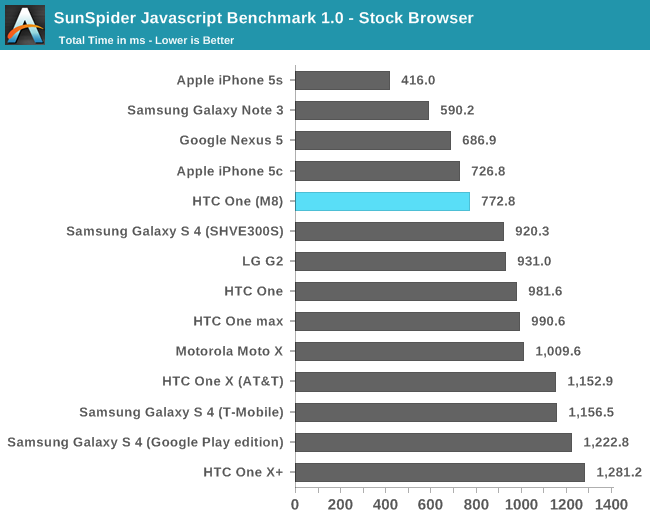
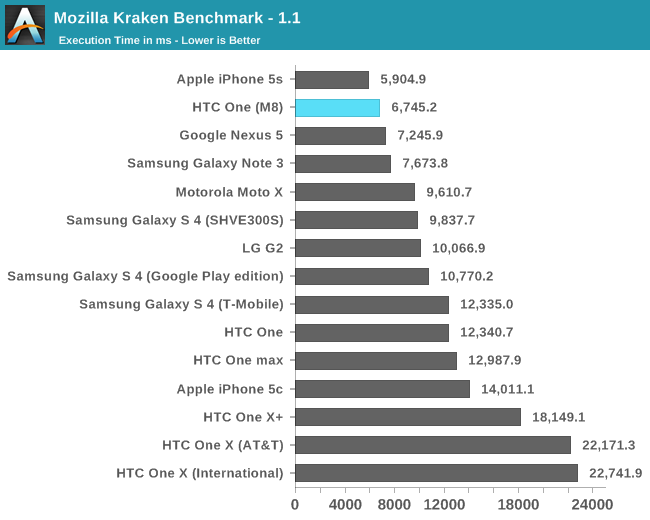
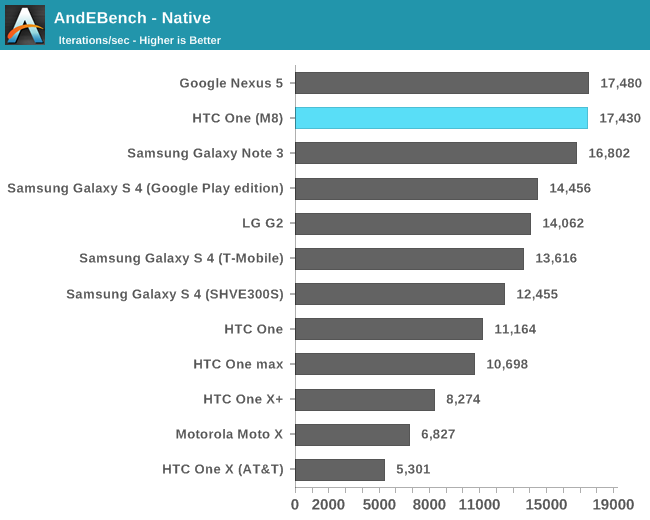
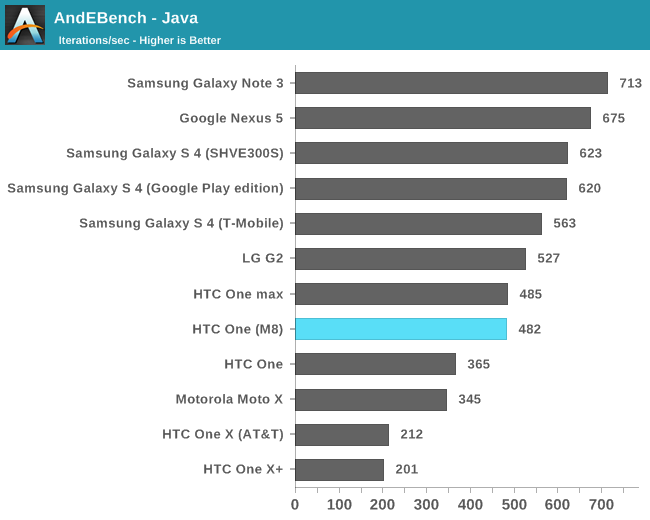
GPU Performance
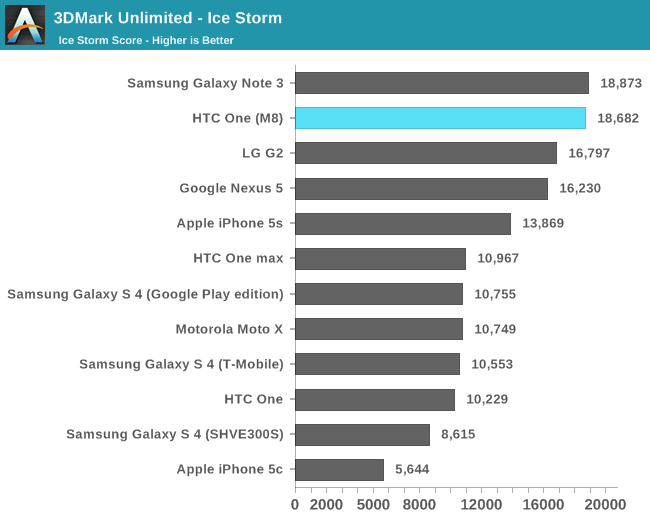
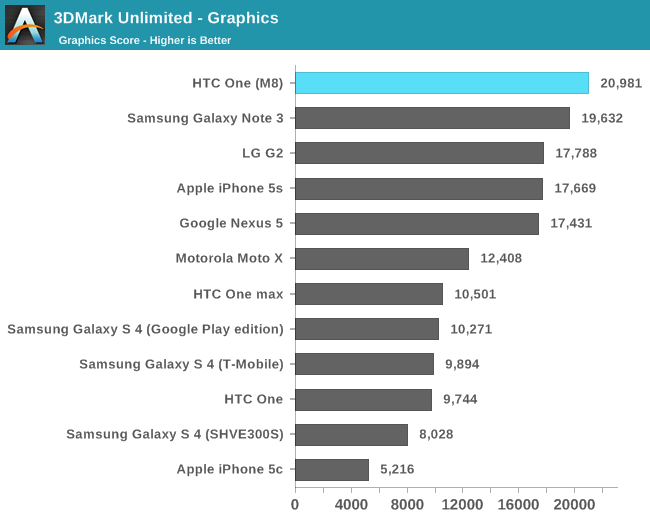
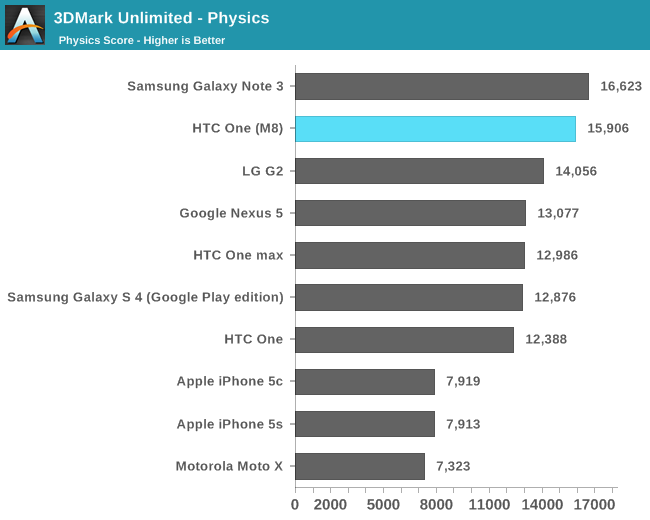
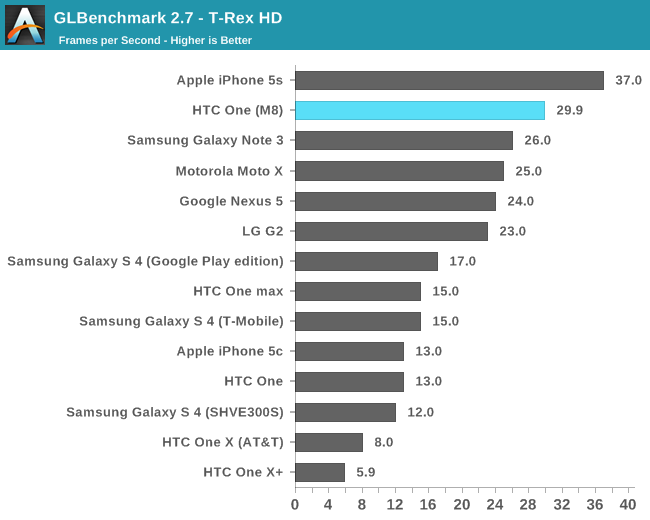
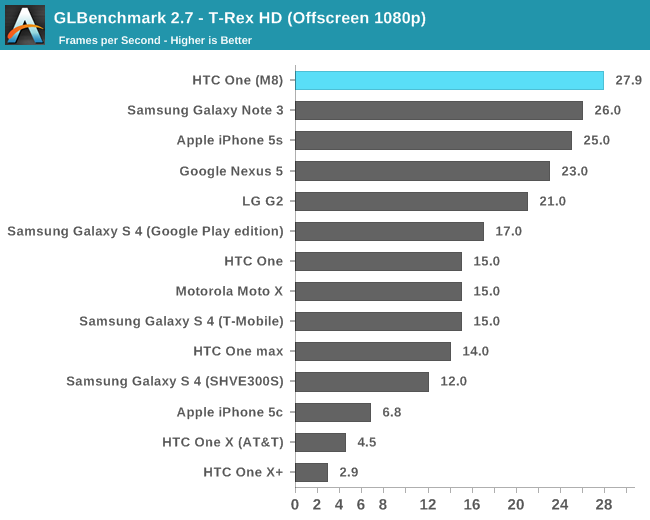
NAND Performance
The One is available in either 16GB or 32GB configurations, there are no higher capacity versions offered. There is now a micro SD card slot on the right side of the device, just above the volume rocker.
Despite using a Snapdragon 801 SoC, the internal storage is still an eMMC 4.5 solution.
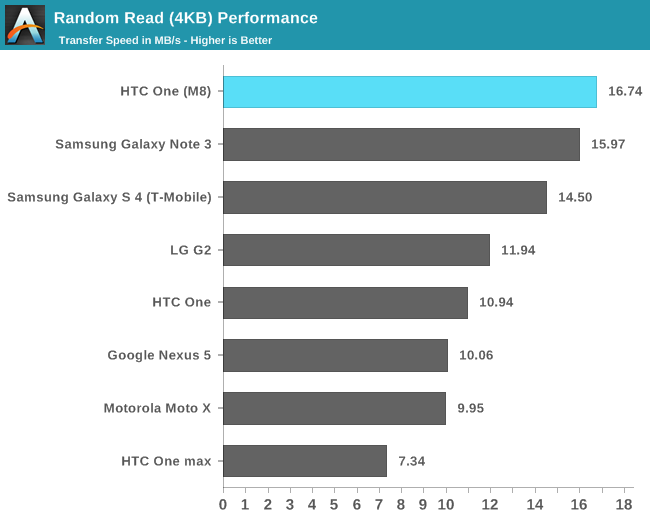
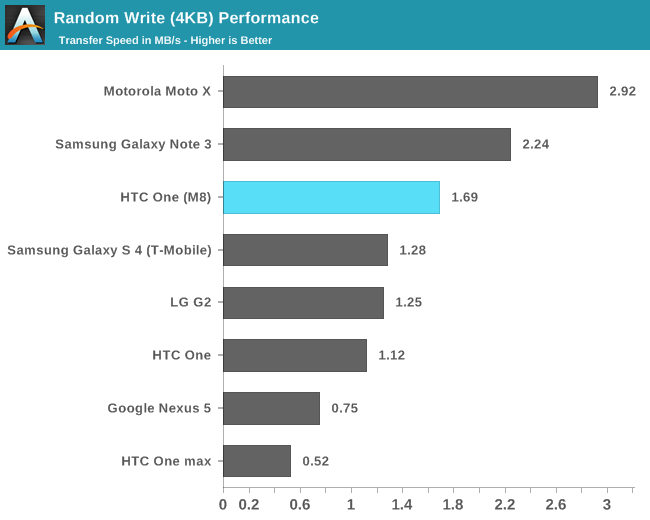

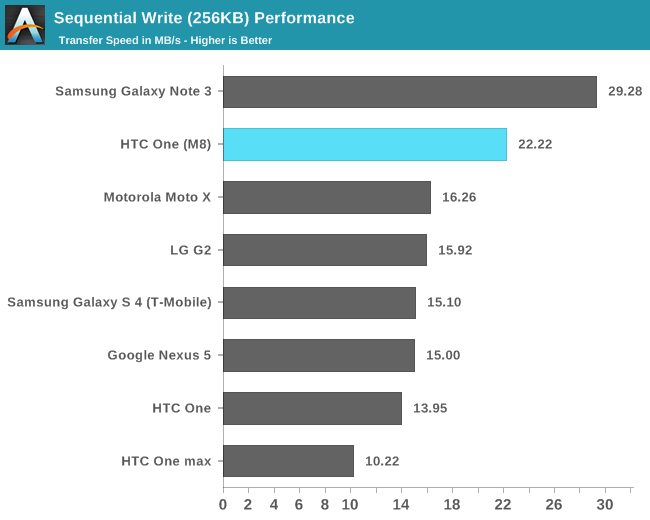


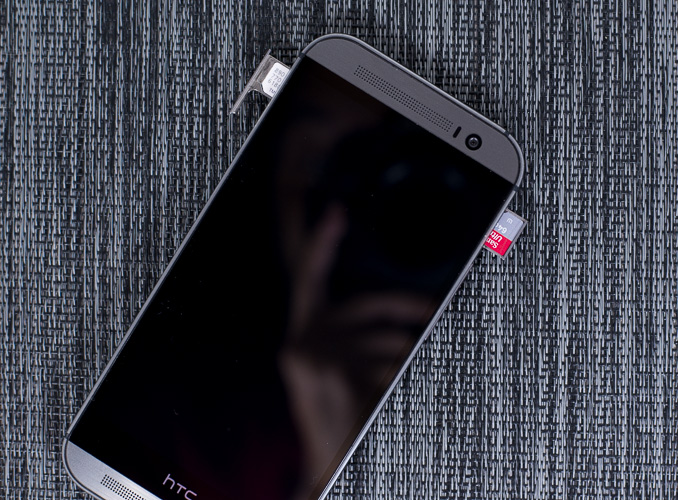








222 Comments
View All Comments
fokka - Wednesday, March 26, 2014 - link
same here. i had hoped they keep it the same size and the bigger screen will be compensated by the on screen buttons. but seeing this huge black bar with the htc logo under the screen just about puts me off considering the new one is almost 1cm taller than the old.the problem is now that the m8 is here i would also feel dumb for buying an m7, the battery and sd slot alone are big selling points for me. but man is this thing big...
madwolfa - Wednesday, March 26, 2014 - link
Remaining happy camper with my M7.. M8 is not a worthy upgrade for me.. Guess shoulda wait for M9. I have another year of contract anyway.hangfirew8 - Wednesday, March 26, 2014 - link
My feelings as well, the M8 is a good fast phone, but I'm happy with my fast-enough M7. I still wish for a better still camera but the video is indeed good and it looks like we'll have to wait for the M9 to get the 6-8MP we need to make UltraPixel both sensitive and detailed.puremind - Saturday, March 29, 2014 - link
Take the new HTC One Mini. It will probably fit thebillhangfirew8 - Saturday, March 29, 2014 - link
Considering how much less the original Mini was compared to the M7, I doubt the new Mini will be better than my M7- which would make it better than the One M8.UltraWide - Wednesday, March 26, 2014 - link
HTC needs to make sure to follow up with prompt Android updates and not drop support for phones like the ONE X+, etc.At the end of the day, I will probably check out the HTC One M8, praise it for all the great points highlighted in this article and just buy the Galaxy S5 because it makes less sacrifices in the name of design.
tipoo - Wednesday, March 26, 2014 - link
They did really well with 2013 One updates, I don't know as much about the One X but I think that got pretty good update speeds too.sigmatau - Wednesday, March 26, 2014 - link
"HTC clearly saw design where others were more focused on cost optimization."Not sure if that matters when "cost optimization" is not passed on to the customer. When they came out, the Galaxy S4 cost more than the HTC One.
Death666Angel - Friday, March 28, 2014 - link
That's almost solely a function of hype/demand. After the great success of the Galaxy S2, Samsung had its bed made and simply needed to offer the new phone with everything a bit improved. Because of HTCs horrible marketing and naming scheme, they didn't have the same level of branding, so their new releases aren't nearly as covered, hyped and sought after.But as I said in my own comment, now the HTC M7 is the priciest of the former flagship phones, coming in at 410€ for the 32GB version, with the other brands bein 300 to 330€ for their 16GB versions. If you compare like to like, it is a bit closer.
hangfirew8 - Saturday, March 29, 2014 - link
Savings from the cost optimization goes into Marketing.